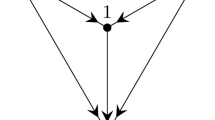Abstract
Hirschfeld and Wheeler proved in 1975 that ∑1 ultrapowers (= “simple models”) are rigid; i.e., they admit no non-trivial automorphisms. We later noted, essentially mimicking their technique, that the same is true of Δ1 ultrapowers (= “Nerode semirings”), a class of models of Π2 Arithmetic that overlaps, but is mutually non-inclusive with, the class of Σ1 ultrapowers. Hirschfeld and Wheeler left as open the question whether some Σ1 ultrapowers might admit proper isomorphic self-injections. We do not answer that question; but we do answer the corresponding question, in the negative, for the Δ1 case.
Similar content being viewed by others
References
Hirschfeld J. (1975). Models of arithmetic and recursive functions. Israel J. Math. 20(2): 111–126
Hirschfeld J. and Wheeler W. (1975). Forcing, arithmetic, division rings. Lecture Notes in Mathematics 454. Springer, Berlin
McLaughlin T. (1989). Some extension and rearrangement theorems for Nerode semirings. Z. Math. Logik Grundl. Math. 35(3): 197–209
McLaughlin T. (1990). Sub-arithmetical ultrapowers: a survey. Ann. Pure Appl. Logic 49: 143–191



